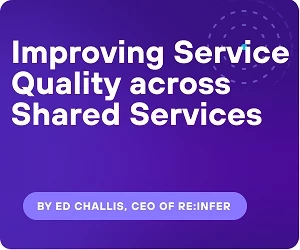Intelligent Automation: Boosting Shared Services Productivity
Add bookmark
Shared services and global business services (GBS) help the business run better. But who is helping shared services agents?
To really enhance the business, to make it operate faster and more efficiently, the shared services centre has to be working at its best. That means removing the low-value tasks and chores which waste agents’ time and expertise.
The rise of hybrid and remote working means there are more employees seeking help from the shared services function than ever. At the same time, there’s increasing pressure on shared services and GBS to create fresh value by providing entirely new services to the business. Any barriers getting in the way of this work need to be removed, enabling shared services agents to do their best work.
Understanding the comms challenge
Communication is one of the most important, but also least efficient, aspects of an agent’s work. Every workflow is based on communication with colleagues and clients - whether it’s through email, service requests or case management systems. On email alone, the average agent sends or receives 126 emails a day, with 40% of their time spent just in Outlook.
But is this time well spent? Much of this comms work is critical, but a great deal of it is also focused on low-skill, time-consuming tasks like requesting missing information or triaging emails between different teams. Indeed, it’s estimated that 50% of all service requests that pass through the service desk are repetitive and minor in complexity - the kinds of requests that should be automated.
Ultimately, manual email processing is a cost centre, a drain on resources and, often, a driver of staff churn. Nearly a quarter (22%) of employees say email volumes make them want to quit their current job. It’s important for shared services leaders to address these issues, but they’ll need to look beyond the familiar tools of process excellence, programme management and automation to do it.
Robotic process Automation (RPA) has been one of the most popular tools for shared services transformation. But, by itself, it’s not well suited to email processing. RPA software robots can’t think like humans or process information like we do. They rely on the clean, structured data that exists in documents, forms and spreadsheets. This makes them unsuited to understanding emails, where comprehension of the free-form, complex language that humans use is critical to performing the right action.
NLP: Efficiency and productivity
An RPA solution could certainly send, reroute or delete an email - but there’s a crucial gap in understanding that needs to be crossed first. That’s why shared services leaders have turned to natural language processing (NLP) solutions. NLP is designed to understand the complex natural language of humans, converting it into structured data that can then be actioned by the business. This makes it ideal for email and communications-based processes.
In the last few years, NLP technology has advanced to such a degree that critical business processes can now run on it. NLP can be deployed safely and reliably, helping shared services leaders understand and then streamline any email or comms-based process.
NLP is only one tool capable of driving digital transformation in shared services. However, what makes it a game-changer is how it extends analysis and automation into business conversations for the first time. When working alongside RPA and other automation solutions, it’s fully capable of taking over repetitive email-based tasks and triggering the appropriate responses to inbound service requests.
This could be transformational for agent productivity. Instead of responding to routine requests on email, or forwarding a message to the right team member, they can focus on resolving complex issues deserving of their time and expertise.
Efficiency gains in one area of shared services spread quickly. Not having to deal with routine email tasks means that even the most challenging request can be dealt with more quickly. Handling times fall across the board and targets are hit more quickly. Agents also win back precious time, giving them the capacity to provide new, value-adding services to the business.
However, there are also dividends for operational insight and intelligence. Other tools like Process Mining can help to work out how efficient a process is, but only NLP enables you to understand what is triggering that process. By analysing communications data through a process known as Communications Mining, NLP helps shared services leaders see what service requests are creating the most workflows and taking up the most time. This valuable insight can inform and feed into everything, from hiring decisions to more effective capacity planning.
Conversational Data Intelligence
NLP has finally matured as a technology. Leading shared services leaders are now leveraging NLP in the back office, where it can serve as a powerful aid to agent productivity. Conversational Data Intelligence is the application of NLP to the business communications that underlie every process in the business. Alongside RPA, it’s key to achieving digital transformation and giving precious time back to agents.
Learn more about how NLP is completing the solution stack for shared services transformation.
















